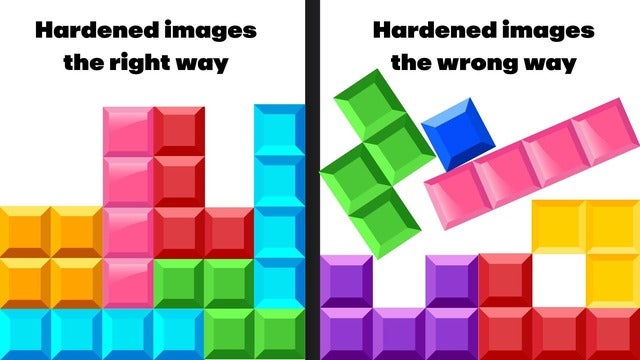
強化されたイメージプロバイダーを評価するときは、「ゼロCVE」や「最小限」などの流行語だけを探しないでください。動的な環境における真のセキュリティには、プロセス、コミットメント、柔軟性を微妙に理解する必要があります。プラットフォーム、DevOps、SecOpsの各チームにとって、これらは、プロバイダーがワークフローを強化する真のセキュリティを提供しているのか、それとも最終的に解決するよりも多くの問題を引き起こすのかを明らかにする重要な質問です。
1。アップデートとパッチ管理:「継続的なセキュリティ」の現実
- 新たに開示された重大度の高いCVEに対応して、イメージをどのくらいの速さで更新できますか?これに関するサービス レベル アグリーメント (SLA) は何ですか?
- なぜそれが重要なのか: これは、露出ウィンドウに直接影響します。パッチ適用プロセスが遅いと、イメージが最初にどれほど「強化」されているかに関係なく、脆弱なままになります。
- 再構築プロセスはどのようなものですか (緊急パッチだけでなく)?
- なぜそれが重要なのか: ソフトウェアのリリースごとに、お金と労力がかかり、リスクが生じます。そのため、毎晩のアップデートを受け取り、理由もなく毎日デプロイすると、コストとリスクが増大します。代わりに、再構築に対するインテリジェントなアプローチが必要です。ベンダーは、すべてのパッケージをカタログ化し、CVES と修正を監視し、必要な場合にのみ行う必要があります。再構築では、インテリジェントなイベント駆動型の体系的なアプローチを利用する必要があります。
- 更新や変更を通知するプロセスは何ですか?これらの更新をどのように利用できますか (例: API、レジストリ フィード、ダイレクト通知を通じて)?
- なぜそれが重要なのか: 手動チェックではなく、自動パイプラインに更新を統合する効率的な方法が必要です。
2。変更プロセス: 「柔軟性」を解き明かす
このセクションでは、プロバイダーが「雪の結晶」の現実をどのように処理するかについて詳しく説明します。「私たちは柔軟です」と言うだけでは十分ではありません。メカニズムと意味を理解する必要があります。
- 強化されたイメージを変更するための正確な技術的プロセスは何ですか (たとえば、Dockerfile、独自のツール、特定のビルド引数を使用)?関連する手順を説明する。
- なぜそれが重要なのか: 実際のワークフローを理解する。それは標準的でオープンなのでしょうか、それとも新しい、潜在的に制限的なエコシステムを学ぶ必要があるのでしょうか?最終的な画像縮小のために多段階ビルドを効果的にサポートしていますか?
- 私たちの変更によって、基礎となる強化が誤って損なわれないようにするにはどうすればよいでしょうか?これらの変更を検証するために、どのような自動チェックまたはゲートが実施されていますか?
- なぜそれが重要なのか: 1 つのパッケージを追加すると、そのセキュリティが無効になると、基本イメージの値は失われます。変更 後 は、統合されたセキュリティスキャン、ポリシーの適用、ベストプラクティスチェック(例:非rootユーザーの適用、ハードコードされたシークレットなし)を探してください。
- 特定の変更が意図したとおりに機能し、機能回帰が発生していないことを検証するために、どのようなメカニズムを提供していますか?(例:テストフレームワークとの統合、事前設定されたヘルスチェック)?
- なぜそれが重要なのか: セキュリティは機能を損なうべきではありません。プロバイダーのエコシステムは、デプロイ 前 に変更されたイメージに対する信頼性をどのように促進しますか?利用可能なテストスイートや検証ツールはありますか?
- カスタム変更要求、またはカスタム変更されたイメージにパッチを適用する場合 (変更を処理する場合) の一般的な所要時間はどのくらいですか?
- なぜそれが重要なのか: 変更の実行をベンダーに依存している場合、ベンダーの速度は俊敏性に直接影響します。納期が遅いと、自動化の利点が損なわれる可能性があります。
- 多様なアプリケーションポートフォリオにわたって多くの独自の変更を必要とする大規模な組織の場合、変更プロセスをどのように管理および拡張しますか?
- なぜそれが重要なのか: 彼らのシステムは企業の複雑さを考慮して構築されていますか?バージョン管理、競合解決、および数百または数千の変更された可能性のあるイメージにわたるパッチの一貫した適用をどのように処理しますか?集中管理を提供していますか、それともポイントソリューションのみを提供しますか?
- 変更により、SBOM の生成と脆弱性スキャンが簡単になりますか? 最終的な 追加を含む変更された画像?
- なぜそれが重要なのか: 完全な透明性は、コンプライアンスとインシデント対応にとって非常に重要です。SBOM は、画像内のすべてを反映する必要があります。
3。サプライチェーンのセキュリティと透明性:信頼しながら検証する
- あなたの画像の完全な出所は何ですか?推移的な依存関係を含むすべての依存関係を含む検証可能なソフトウェア部品表 (SBOM) を提供できますか?
- なぜそれが重要なのか: 画像の中身と、ソースからバイナリまで、すべてのレイヤーで画像がどこから来たのかを正確に知る必要があります。
- サプライチェーンのセキュリティ(SLSA、再現可能なビルドなど)については、どのような基準に準拠していますか?これをどのように実証できますか?
- なぜそれが重要なのか: CVEだけでなく、イメージの構築と配信の プロセス はどの程度安全ですか?
- イメージ内のサードパーティ コンポーネントとオープンソース ライセンスをどのように処理しますか?
- なぜそれが重要なのか: コンプライアンスはセキュリティだけではありません。それは法律の遵守に関するものです。
- 悪用不可能な脆弱性を処理し、VEX を使用して到達可能な脆弱性を明確にするプロセスは何ですか?この情報は透明性を持って提供されていますか?
- なぜそれが重要なのか: 報告されたすべてのCVEが、イメージのコンテキストで実際に悪用可能でない場合、追跡することは望ましくありません。
4。サポート、統合、エコシステムの互換性: 画像自体を超えて
- 強化されたイメージは、一般的な DevOps ツールや CI/CD プラットフォーム (Kubernetes、Jenkins、GitLab CI、Argo CD など) とどのように統合されますか?
- なぜそれが重要なのか: 既存のツールチェーンに適合しない安全なイメージは、摩擦と抵抗を生み出します。
- 強化されたイメージ自体に関連する問題と、その上で実行されているアプリケーションに関連する問題に対して、どのレベルのサポートを提供していますか?
- なぜそれが重要なのか: トラブルシューティングの責任範囲が明確であれば、インシデント発生時の時間を大幅に節約できます。
- セキュリティチームに専用のサポートチャネルや専門知識を提供していますか?
- なぜそれが重要なのか: セキュリティチームには特定のニーズがあり、多くの場合、セキュリティの専門家に直接アクセスする必要があります。
- 価格モデルは何ですか?潜在的なカスタマイズコストを考慮して、使用状況と組織の成長に合わせて効果的に拡張できますか?
- なぜそれが重要なのか: 多くの変更された画像を管理する複雑さを考慮して、ステッカー価格を超える総所有コストを理解します。
これらの難しい質問をすることで、プラットフォーム、DevOps、SecOpsの各チームは、マーケティング上の主張を超えて、安全でアジャイルなソフトウェア配信の現実世界の要求に基づいて、強化されたイメージプロバイダーを評価できます。











